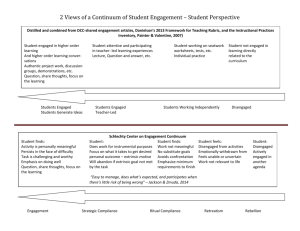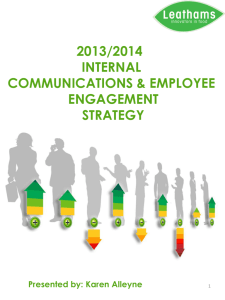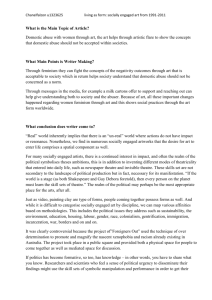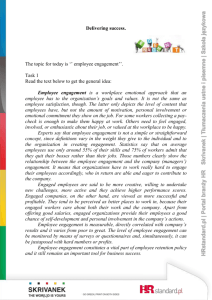EngagEd AND INVOLVED
advertisement
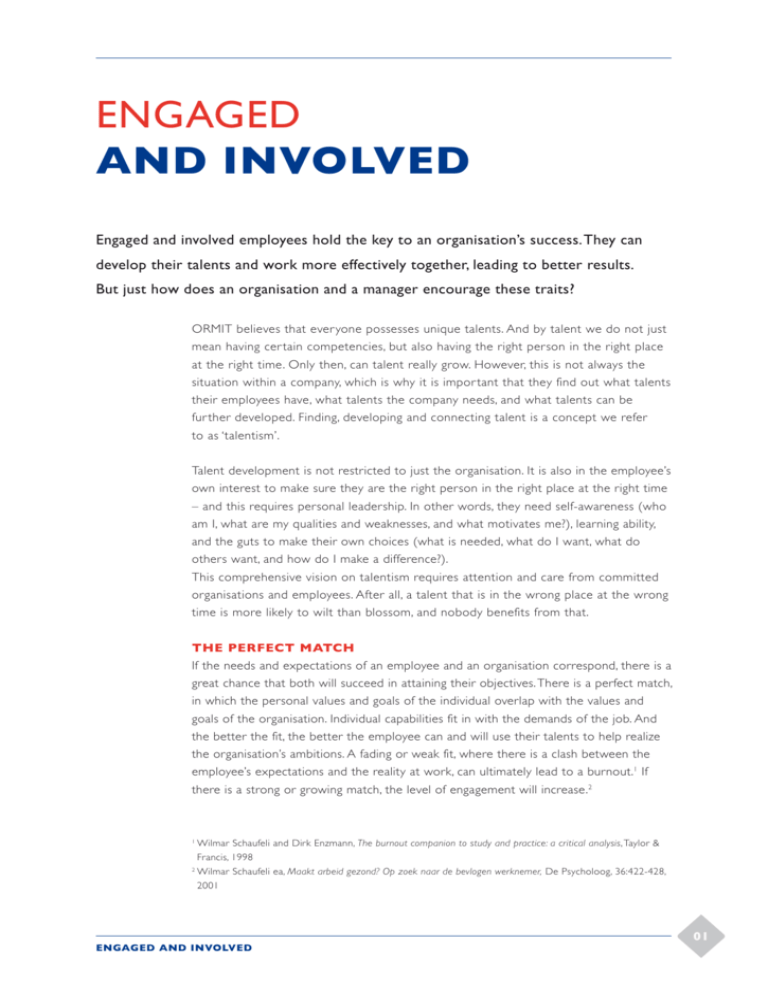
Engaged and involved Engaged and involved employees hold the key to an organisation’s success. They can develop their talents and work more effectively together, leading to better results. But just how does an organisation and a manager encourage these traits? ORMIT believes that ever yone possesses unique talents. And by talent we do not just mean having cer tain competencies, but also having the right person in the right place at the right time. Only then, can talent really grow. However, this is not always the situation within a company, which is why it is impor tant that they find out what talents their employees have, what talents the company needs, and what talents can be fur ther developed. Finding, developing and connecting talent is a concept we refer to as ‘talentism’. Talent development is not restricted to just the organisation. It is also in the employee’s own interest to make sure they are the right person in the right place at the right time – and this requires personal leadership. In other words, they need self-awareness (who am I, what are my qualities and weaknesses, and what motivates me?), learning ability, and the guts to make their own choices (what is needed, what do I want, what do others want, and how do I make a difference?). This comprehensive vision on talentism requires attention and care from committed organisations and employees. After all, a talent that is in the wrong place at the wrong time is more likely to wilt than blossom, and nobody benefits from that. The perfect match If the needs and expectations of an employee and an organisation correspond, there is a great chance that both will succeed in attaining their objectives. There is a perfect match, in which the personal values and goals of the individual overlap with the values and goals of the organisation. Individual capabilities fit in with the demands of the job. And the better the fit, the better the employee can and will use their talents to help realize the organisation’s ambitions. A fading or weak fit, where there is a clash between the employee’s expectations and the reality at work, can ultimately lead to a burnout.1 If there is a strong or growing match, the level of engagement will increase.2 ilmar Schaufeli and Dirk Enzmann, The burnout companion to study and practice: a critical analysis, Taylor & W Francis, 1998 2 W ilmar Schaufeli ea, Maakt arbeid gezond? Op zoek naar de bevlogen werknemer, De Psycholoog, 36:422-428, 2001 1 Engaged and involved 01 Engagement and burnout are two sides of the same coin. Psychologists Michael Leiter and Christina Maslach define burn-out as exhaustion, mental detachment and a sense of incompetence. They describe engagement with words such as energy, involvement and efficacy.3 According to Wilmar Schaufeli and Arnold Bakker, both professors of work and organisational psychology, burnout and engagement can alternate. Engaged employees can burn out, but burnt out employees can also become engaged again. Incidentally, engaged employees may occasionally be tired, but it is not a tiredness that disables as a burnout does. It is a tiredness that is more likely to lead to a feeling of satisfaction.4 Better to be engaged than satisfied A strong match creates engagement. Schaufeli and Bakker5 define engagement as a state of fulfilment characterised by vigour, dedication and absorption: V igour An employee with vigour is highly energetic, does not tire quickly, has a high level of mental resilience, is willing to invest effor t in their work and is persistent in the face of difficulties. D edication A dedicated employee is strongly committed to their work, is enthusiastic and proud of what they do, has a sense of significance, and is challenged and inspired by their work. A bsorption An employee that is absorbed by their work is happily engrossed in their tasks, forgets about other things and feels time passes quickly. Absorption is also referred to as flow. The question is whether or not engaged employees are also satisfied employees. To a cer tain extent, engagement and satisfaction have a lot in common; both engaged and satisfied employees are highly productive and give clients a positive impression. ­H owever, there is an impor tant difference, namely that engagement goes hand in hand with action, while satisfaction can comprise satiation and passivity. hristina Maslach and Michael Leiter, The Truth about Burnout: How Organizations Cause Personal Stress and C What to Do About It, Jossey-Bass, 1997 4 W ilmar Schaufeli and Arnold Bakker, Burnout and Work Engagement in De Psychologie van Arbeid en Gezondheid, Bohn Stafleu van Loghum, 2003 5 W ilmar Schaufeli and Arnold Bakker, Work and well-being: towards a positive approach in occupational health psychology, Gedrag & Organisatie, 14:229-253, 2001 3 Engaged and involved 02 ex se tle ed cit ACTIVE ten re s h ap ss WORK­ AHOLIC ENGAGED UNPLEASANT PLEASANT BURNT OUT ble SATISFIED ser en e m tir cal ed m ra ise py PASSIVE Circumplex of well-being6 Satisfaction is characterised by serenity and calmness, whereas engagement leads to feelings of excitement and happiness. Satisfied employees simply do their work, are fine with it and tend to mark time. A higher degree of satisfaction does not therefore necessarily lead to better results for the company. The benefits of engagement Engaged employees are active. They are more productive, take on extra tasks and are more willing to help their colleagues.7 Engagement creates a higher degree of work satisfaction, an increase in self-initiative, and a motivation to learn. Employees can take on more, are less likely to call in sick, and when they are sick, they recover more quickly. There is also a positive relationship between engagement and company performance. Research carried out by the American James Har ter8 showed that teams with numerous engaged people scored significantly better in terms of turnover (12% more), customer satisfaction (12% more) and productivity (18% more) compared to teams with only a few engaged members. And there was less employee turnover. James Russel, Core Affect and the Psychological Construction of Emotion, Psychological Review, 110:145-172, 2003 Willem van Rhenen, From stress to engagement, ArboNed/Coronel Instituut AMC Amsterdam, 2008 8 James Harter, Frank Schmidt and Hayes, Business-unit level relationship between employee satisfaction, employee engagement and business outcomes: A meta-analysis, Journal of Applied Psychology, 87:268-279, 2002 6 7 Engaged and involved 03 Recruiting for engagement One way of increasing the level of engagement within a company is to recruit engaged people. Some people are simply more susceptive to engagement than others.9 Engaged people: Can cope better with setbacks (are emotionally stable) Work with a focus (are conscientious) M ore actively maintain contacts and with more pleasure (are extraver t) S et higher standards for themselves and want to do more to attain goals (are ­p erformance motivated) A re willing to take on more responsibility for their decision (take ownership) H ave a more positive image of themselves (have self-value) B elieve they have the qualities to do what they want to do (believe in self-efficacy) F eel responsible or par tly responsible for results (recognise internal attribution) M ore actively deal with problems and obstacles (are able to cope) An additional advantage of recruiting engaged job applicants is that engagement is, to a cer tain extent, contagious. New, engaged personnel often pass their engagement on to others within the organisation. Captivate and connect In addition to ensuring a good match of employee, tasks and organisation, other ways of encouraging engagement include the following:10 P urpose Be clear about the purpose of your organisation, make sure the employee knows, sees and feels that their work has added value. Values Communicate clearly and consistently on the values of the organisation and act accordingly, both internally and externally. Trust Strengthen the trust employees have in the organisation and strengthen the trust managers have in their employees. G oals Define goals that can be understood by employees and that will inspire them. Clarify the advantages and the values they serve. F airness Divide tasks, salaries, appreciation and par ticipation fairly. L eadership Encourage a style of leadership that not only results in turnover, but also takes into account the needs and development of the employees. L isette Boot, Tamara Lagas and Herman Steensma, Resultaten onderzoek werkbevlogenheid, inzichten en suggesties, Humanage, 2008 10 See 9 9 Engaged and involved 04 Increase engagement in five steps 1. Think about the match Sit down regularly with your employees to talk about the extent to which each other’s expectations are being met. Be open. Enter into the discussion about what you expect from your staff and find out what they need in order to be able to apply their talents more effectively. Talk about what you can both do if the match becomes weaker. 2. Clarify what you as an organisation think is important See values as more than just a few well-formulated words. Specifically define the desired behaviour that demonstrates the organisation’s values and ensure that they are at the core of the way in which managers and staff carry out their tasks. Confront each other if it is not the case. Lay down the values in HR processes and tools, for instance through performance management. 3. Nurture what is good, improve where possible Focus on what works well. Appreciate and nur ture what is good, and improve where possible. Develop the organisation by doing more of what it is good at. Celebrate and share successes with each other. Emphasise people’s talents. Delegate tasks and ­responsibilities according to employees’ talents. 4. Consider diversity as an opportunity Encourage management to better apply the various talents of their staff when allocating goals and tasks. Help managers develop their skills in situational leadership. Challenge employees to apply their own ideas to the organisation’s dilemmas and oppor tunities for improvement. 5. Promote a positive learning environment Develop personal leadership in managers and employees so that they are more open and motivated for development. Steer them towards developing their strong points and reward effor t, not just result. Find more information on www.ormit.be or contact us on +32 (0)2 533.98.90. Engaged and involved 05



